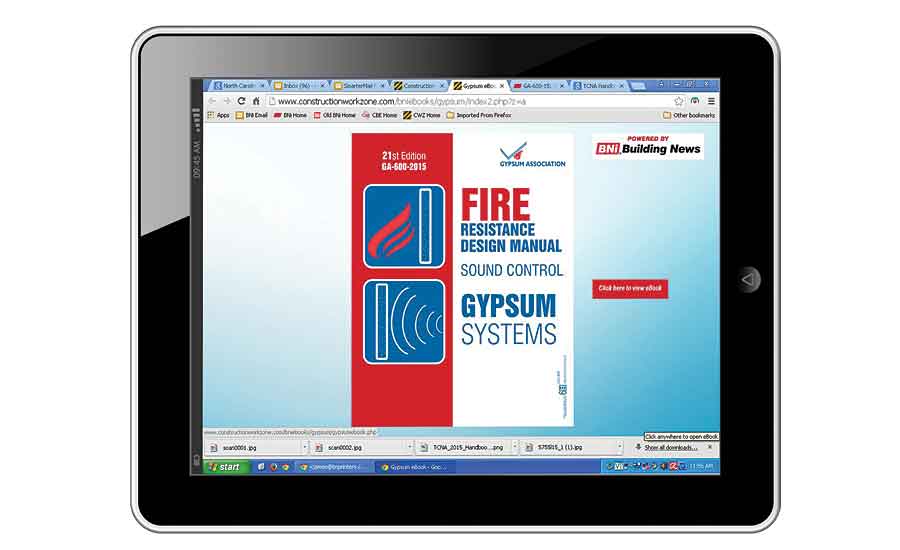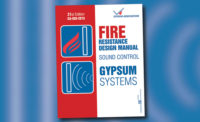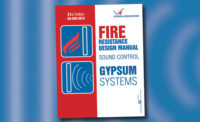As I write this, the 21st edition of the Gypsum Association’s Fire Resistance Design Manual(GA-600-2015) has been on the street for only a month. While the majority of users have continued to order the traditional hardcopy version, 16 percent are taking advantage of the e-book, which allows users to search through the 300 page book by word or phrase. Interestingly, that 16 percent is exactly the percentage of users predicted to be innovators and early adopters by what is called the “technology adoption lifecycle.”
Everett M. Rogers first described this theory about how, why, and at what rate new ideas and technology spread in his book Diffusion of Innovations. Published in 1962, the book, now in its fifth edition, remains highly relevant today.
While GA-600 has always been well organized, the digital GA-600-2015 takes “user-friendly” to the next level, with a fully linked table of contents that allows readers to directly access specific sections of the book, such as shaft walls with a 3-hour fire rating. In addition, a full text search displays detailed results on the left hand side of the computer screen. The search function is particularly useful when seeking a specific element in a fire rated assembly. For example, cellulose fiber insulation has become an increasingly popular. By searching on the term “cellulose fiber” it is easy to learn exactly when the addition of this type of insulation is acceptable or unacceptable, as the e-book takes users quickly and easily through every reference to cellulose fiber insulation.
Becoming More Efficient
From the pertinent general explanatory notes, we learn that, when not specified as a component of a fire-rated system, cellulose fiber insulation can be added to assemblies, such as partition walls, to improve the sound transmission class. However, in a floor-ceiling or roof-ceiling assembly, the specified type of insulation should not change from the tested design. Additional insulation is acceptable, as long as the cavity is deep enough to accept it; but additional layers of wall board are also necessary. Clicking on the final two search results, I find a single 1-hour rated roof-ceiling assembly as well as a 1-hour rated floor-ceiling assembly that contain cellulose insulation.
I recently learned that many specifiers prefer to reference a generic system in their specs. That too, is made easier by the e-book. If I type “generic” into the search bar I get a lengthy list, but also I receive enough information in the search results that I can easily scroll through to find the type of wall I’m looking for, and quickly review those with the appropriate STC and fire rating. On the other hand, if my preference is for a specific manufacturer’s product I can perform a similar search, with similarly helpful results.
Here at the Gypsum Association we maintain a staffed technical hotline and we are always ready and willing to answer questions related to fire resistant assemblies; however, we have noticed that many questions from architects and from contractors are solved when both entities are on the same page, and I mean that quite literally, i.e. on the same page of the manual. The new e-book makes it easier than ever before to include specific assemblies in construction documents or to communicate across disciplines about interior systems during design development.
For example, if an architect asks the specifier for a generic shaft wall system he or she could offer one of the two generic shaft wall systems with a 2-hour rating that are published in both GA-600-2012 and GA-600-2015. However, each assembly requires four layers of generic 5/8-inch type X gypsum panels. However, all 1-foot by 24-inch type X boards (AKA shaftliner) are proprietary, and given the time constraints and the many limiting conditions often imposed by shaft walls, it is often more fruitful for the specifier to suggest one or more proprietary listings that meet the required fire rating.
Sharing that information is easy. Using the e-book’s PDF creation function, a user simply clicks on the printer icon, and a pdf is generated in another tab. The PDF consists of two pages of assemblies but it is easy to reference the GA file number of the preferred system or systems an email and attach the pdf for reference. Another option is to use an Adobe Acrobat tool, such as the snipping tool, to extract the desired assembly, which can be saved as another PDF and/or emailed directly from the snipping tool to the desired recipient.
Similarly, if a contractor encounters unanticipated existing site conditions, or a code official has questions about the assembly specified, generating a PDF or several PDFs as a basis for discussion and agreement about which system is most appropriate can save time, while reducing some of the burden associated with request for information and change orders.
Change is a Good Thing
Concerned about copyright? Page one of the Fire Resistance Design Manualstates that “limited permission is hereby granted to design professionals to selectively reproduce individual systems in the routine course of their design work for inclusion in plans and specifications for individual projects.”
Change isn’t always easy, even for innovators and early adopters. In fact, these change agents are valuable precisely because they are the most likely to point out problems, help to resolve issues and improve products. In short, they are likely to complain but are also willing to embrace new ideas. Consider the email below received from an e-book user, who was initially a little frustrated and skeptical:
“When I first ordered the digital version, I was not sold but now after a few weeks I just love this [thing.] I am sure I have not figured out all the “bells & whistles,” but so far it has been a really nice resource for me.”
The e-book version of GA-600-2015 is currently being offered with a complimentary copy of the hard copy version. The e-book is single user and can only be accessed via one PC or Mac. Registration on www.constructionworkzone.com (registration is free) is necessary to access the e-book. After purchase, through the GA bookstore, call 1.888.264.2665 (M-F) between 9:00 AM and 7:30 PM Eastern time, to confirm purchase and activate the publication in your personal e-book library.
Last, but certainly not least, we should also note that Evaluation Report ESR-1338 issued to the Gypsum Association has been reissued by ICC Evaluation Service LLC, (ICC-ES). The reissued report will remain valid until February 2016. The report indicates compliance with the 2015, 2012, and 2009, International Building Code and the 2015, 2012, and 2009 International Residential Code. As a result of the revision of ESR-1338, the recently released Fire Resistance Design Manual(GA-600-2015) both hardcopy and digital is an acceptable source of fire-resistance and sound-control systems.
Whether you embrace the new technology or prefer to stick with the tried and true, the Fire Resistance Design Manualremains the go-to resource for fire-resistant assemblies that meet or exceed requirements.





Report Abusive Comment